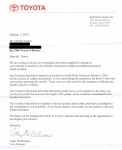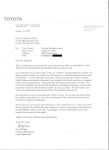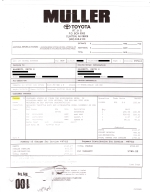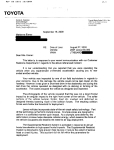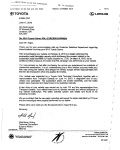Michael Teston, Maaumelle, AR
Michael Teston was driving into a small town in his 2006 4Runner with the cruise control on. He reports tapping the brakes to disengage the cruise, the cruise control then disengaged and the vehicle began to slow. Teston coasted with his foot on the brake as he approached a parking lot for a convenience store. He turned into parking lot at approximately 15 mph, still coasting with his foot on brake. As his speed reduced to approximately 3 to 5 mph, Mr. Teston reports that he heard the ABS brakes activating followed by clicking sound when the engine raced to full-throttle. The vehicle surged forward and hit a pole approximately three feet in front of him. Once the vehicle impacted the pole, the rear of the vehicle began hopping as the rear tires continued to spin. Mr. Teston placed the vehicle into Park and the engine maintained wide-open-throttle until the ignition was turned off. There were two witnesses to the event. Mr. Teston’s vehicle was fitted with OE carpeted floor mats that were in place and secured.
Toyota Response: North Point Toyota in North Little Rock inspected Michael Teston’s vehicle, holding it for three weeks. The dealer determined that there was nothing wrong with the vehicle. A Toyota Technical Specialist examined the vehicle on January 4, 2010. In a letter to Mr. Teston dated February 3, 2010, from Gulf States Toyota, Inc., the company noted that during the inspection, the driver’s floor mat was in place and properly secured and there were “no codes stored in the computer to indicate any product concern or failure.” However, the letter went on to state: “Our Technical Specialist noted that aftermarket pedal covers were installed on the brake and accelerator pedals that increased the length of the pedals, which could have contributed to the accident described.”
Mr. Teston purchased the “aftermarket pedal covers” from a Toyota dealer as a Toyota accessory and these parts were installed by the Toyota dealer.
Click below to see Toyota’s response letter and an enlarged photo of the pedals.
Paul McClean, Laguna Beach, CA
On Sept. 11, 2009 McClean and his wife were driving on Highway 395 in the Mojave Desert for a weekend camping trip, when he overtook another car at approximately 75 miles per hour. As he returned to the lane, he depressed the brake, but his 2008 Highlander Hybrid continued to accelerate. At each application of the brake, the engine whined alarmingly but the car continued to accelerate. Several times, he pressed and released the accelerator followed by returning his foot to the brake, but the vehicle continued to accelerate, unhindered. At 95 mph, he applied both the brake pedal and the emergency brake at the same time forcing the car to slow down, all the while the engine continued to rev up. As it slowed, his wife pushed the gear shift into park and they bounced and shuddered to a halt.
The McCleans resumed their trip, and over the weekend they noticed all manner of bizarre behavior in their Highlander. Paul noted that the brakes were not working properly — although still functional. The vehicle took longer to stop and there was a grinding sound and shuddering very time they tried to slow down. Once, they attempted to turn off the car, the dashboard and control panel lights went haywire and a warning flashed up that the brakes were not functioning and the vehicle needed immediate repair. The messages did not reappear when Paul re-started the car a few hours later. By the time they were ready to return home, the vehicle could not be started without the aid of jumper cables. The brakes were still grinding and shuddering all the way home. (Play video below to hear the McClean’s story.)
Toyota Response: The dealer, Tustin Toyota, inspected the vehicle and claimed that that it had identified the problem: errant floor mats that had entrapped the pedal and the brakes were just fine.
Paul McClean reluctantly picked up his car. The next day Saskia McClean was driving their kids to school in the Highlander, when the lights on the dashboard and control panel went haywire again and the brakes resumed grinding. Then the McCleans heard about the Santee crash that killed the Saylor family.
“We could no longer contemplate using this vehicle to transport our family considering the fate of those poor people and that the same thing would have happened to us if we had been in a built up area and not on an empty desert highway,” Paul McClean said. “That afternoon I drove the car down the hill from where we live to the dealer. Along the way I noticed the same problems with the brakes, the lack of responsiveness and the grinding noise. At the dealer’s we told the Service Director and the Service Manager that we no longer wanted the car, that we did not consider it a safe vehicle for our family, no matter what their computers were telling them in the service department. My wife was visibly distraught at the dealership but the attitude of the Director and Manager was completely unsympathetic and rude, but that is another story.”
The McCleans looked into going after Toyota under California’s Lemon law, but decided that it was too difficult. The traded in their Highlander for a Yukon.
Elizabeth James, Eagle, Colorado
James flipped her 2005 Prius after it raced out of control on Interstate 70 at 90 miles per hour. James applied the brake and the emergency brake, while looking for a safe place to crash her vehicle, did not stop the vehicle. She eventually steered her runaway Prius through the woods, hit a shed, and landed in a river. She still suffers long-term injuries to her legs and back and stomach as a result of the crash. (View the video below to hear Elizabeth James tell her story.)
Toyota Response: After James attempted to recoup $15,000 in medical costs from Toyota, she received a letter from the company blaming the incident on excessive brake wear: “We are sure she believes that her vehicle accelerated on its own; but our inspection of her vehicle did not reveal any evidence to support her allegations,” the letter said. (Read Toyota’s letter below.)
Kevin Haggerty, Pittstown, NJ
Kevin Haggerty, owner of a 2007 Avalon, experienced SUA multiple times; he did not have accessory floor mats, and the OE mats were secured in place. Haggerty reported five SUA events. Several times, the vehicle accelerated without his foot on the gas pedal. The engine would return to idle after driving a few miles or after the Avalon shut down and restarted or was stopped and put into park. Haggerty’s vehicle was checked at the dealership, but they could find nothing wrong. According to his NHTSA complaint:
“Then on 12/28/09 I was driving to work on a major highway. The car began to accelerate without my foot on the gas pedal. As I pushed on the brake, the car continued to accelerate. At that time I was not able to stop my vehicle by pressing hard on the brake. The only way I was able to slow the car down was to put the car into neutral. I took the next exit, which was the exit for the Toyota dealership. I called the dealership and told the service manager to meet me outside because I was experiencing acceleration problems. I drove approximately 5 miles by alternating from neutral to drive and pressing very firmly on the brakes. As I pulled into the front of the dealership I put the car into neutral and exited the car. With the brakes smoking from the excessive braking and the car’s rpm’s racing the manager entered my car. He confirmed that the mats were properly in place and confirmed the rpm’s were very high.”
Toyota Response: The Toyota dealer contacted Toyota’s regional representative in Caldwell, NJ who later inspected the vehicle, but did not provide details of this inspection to Haggerty. However, Toyota Motor Sales authorized replacement of the throttle body and accelerator pedal assemblies and sensors and paid for the $1700 repairs and rental car costs. The Toyota dealer told Haggerty that the vehicle’s computer had stored no error codes and they were unsure whether the repairs would fix the vehicle.
Click below to see Kevin Haggerty’s 2/24/10 testimony to the House Oversight and Government Reform Committee and his invoice from the dealer.
Marianna Eisner, Lake Oswego, Oregon
On August 27, 2009, Marianna Eisner was driving her 2007 Lexus ES 350 on Interstate 205 northbound, near the town of Gladstone, when she noticed that her vehicle speed was climbing from 55 mph to about 75 mph. Eisner applied the brake and then the emergency brake, but neither had any effect except to slightly and temporarily slow the rate of acceleration. Eisner battled her accelerating Lexus for nearly four miles, before she made the decision to get off the highway. She exited at Estacada, and her Lexus slowed slightly on the incline of the ramp. In front of her was a pick-up truck waiting at a stop light at the top of the ramp. Eisner attempted to avoid him, but wound up crashing her Lexus into the rear of the truck. Miraculously, Eisner was unharmed, the driver of the truck and a third driver, who hit Eisner’s vehicle in the rear, suffered only minor injuries. (Play video below for Marianna’s story.)
Toyota Response: The Lexus was towed to the dealership, where a diagnostic scan showed no trouble codes. Instead, the dealer blamed the floor mats. Eisner and her husband pointed out that the floor mats were no where near the accelerator pedal. Toyota corporate eventually sent out a technician, but, again, that examination produced no root cause for the incident. (Read the letter below.)
Eisner was first in line when the automaker announced the floor mat recall and had her Lexus serviced with a new mat, accelerator pedal and the brake to idle override.
“I’m driving the car with my fingers crossed,” Marianna Eisner says.
Brian Blackman and Rosemary Moran, Powell River, British Columbia, Canada
Blackman and Moran owned a low-mileage, five-week-old 2010 RAV4. On Nov. 11th, Brian Blackman phoned his wife, Rosemary and reported: “Something terrible just happened.” Blackman was driving into the driveway, and was almost stopped and ready to put the car into park, when the RAV4 took off. Blackman put his foot on the brake, but the vehicle continued to accelerate. Blackman slammed the vehicle into Park and the vehicle stopped, but the engine continued to race. He pressed the stop/ start button and finally, the engine quit. The incident occurred in a matter of 4-5 seconds, but the experience really shook him up. He realized that had he not reacted, he would have crashed into the deck of their home. After the incident, the couple turned to the dealer, Rice Toyota of Vancouver Island, for a refund.
Toyota Response: Three engineers came to inspect the vehicle, and after two days, the couple got a call from Toyota Canada would buy back the vehicle. On Nov. 22, Blackman said that he signed the vehicle over to Toyota and was told that the vehicle was going to Japan or California for further analysis.
Rosemary Moran said via e-mail : “Toyota gave us all our money back, (over $40,000 Canadian). They have never said why we were given our money back. They said they couldn’t find anything wrong with our car, but took it away to examine it and they said that they would get back to us when they found out what the problem was. We have not heard one word.”
David and Debrah Auger, Chatham, Ontario, Canada
Within six weeks of leasing a 2010 Camry from Campbell Toyota, both Debrah and Dave Auger experienced three bouts of sudden acceleration.
Two incidents occurred when Debrah was at the wheel. The first took place in the parking lot of a small strip plaza. Debrah was parking, and had shifted into reverse, when the vehicle “jolted back quite hard,” Debrah recalled. She threw the transmission shift into park. The incident was puzzling, but the Augers passed it off as a one-time glitch.
Dave Auger, an experienced law enforcement officer, was driving at about 30 miles per hour on a four-lane highway in Port Huron. He had just taken his foot off the gas, when the Camry suddenly surged forward. “It felt like a hand suddenly shoved the car forward,” Auger said. He quickly applied the brakes and pulled the vehicle to the side of the road.
The second incident persuaded Dave Auger that the surges were more than a one-time anomaly. He took the vehicle to the dealership, Campbell Toyota, when technicians said they found no problems. Nonetheless, Campbell Toyota technicians replaced the accelerator pedal under the sticky pedal recall.
The third and final experience occurred as Debrah Auger was pulling up to a one-way stop in the Augers’ subdivision. She had made a complete stop, and had taken her foot off the brake, when the Camry took off. Debrah jammed on the brake, but she couldn’t stop it before the vehicle had surged into the intersection.
“It shocked and frightened me. The car just went – so fast that it threw my head back,” Debrah said. “I pulled into the driveway and my husband said, Don’t touch it. We’re done with that car.”
Toyota Response: Up until their SUA experiences, the Augers were Toyota fans who had owned several over their years of driving. But the Toyota response has soured them on the brand. After the third incident, the Augers had the vehicle towed to dealership, where Dave wanted to leave it, sans license plates, fearing they could be stolen from the unsecured lot. The Toyota entity managing the lease informed Dave Auger that if he left the vehicle on the lot without the plates, it would be considered an abandonment and his credit would suffer.
The Augers had the Camry towed back to their driveway, where Debrah festooned it with big handmade pictures of bright yellow lemons and a sign “Courtesy of Toyota Canada and Campbell Toyota.”
The Augers reported the incidents to Transport Canada, as they did battle with Toyota’s customer service representatives. At various times, dealership personnel suggested that Debrah didn’t know how to drive the Camry or was unaccustomed to ABS brakes; Toyota Canada representatives suggested that the floor mat was to blame and informed the Augers that they would not buy them out of their lease or take the vehicle back.
After the Augers got some news coverage of their lemon-plastered Toyota, the company relented and agreed to inspect the vehicle. On June 14, a Toyota technician examined the vehicle with a representative of Transport Canada present. Three days later, the Augers received a letter from Toyota stating that the inspection revealed no problems with the vehicle:
“A diagnostic test of your vehicle was completed. The accelerator pedal, the throttle assembly, and the brake system were inspected and determined to be operating normally.
A test drive of your vehicle was carried out by both TCI and the representative from Transport Canada. Your vehicle was found to operate normally and without evidence of any vehicle malfunction. The brake override system was tested and found to be operating normally. We are confident that the campaign remedies addressed the defect identified by TCI and that the campaigns were properly performed by our dealer.”
The Augers had asked for copies of the diagnostic tests performed, but Toyota declined to make them available. Transport Canada, however, has agreed to share the results. The Augers are currently stuck making lease payments of a vehicle they are too frightened to drive. They have made no headway in getting Toyota Canada to take back the vehicle.
Click below to see Toyota’s response letter.
